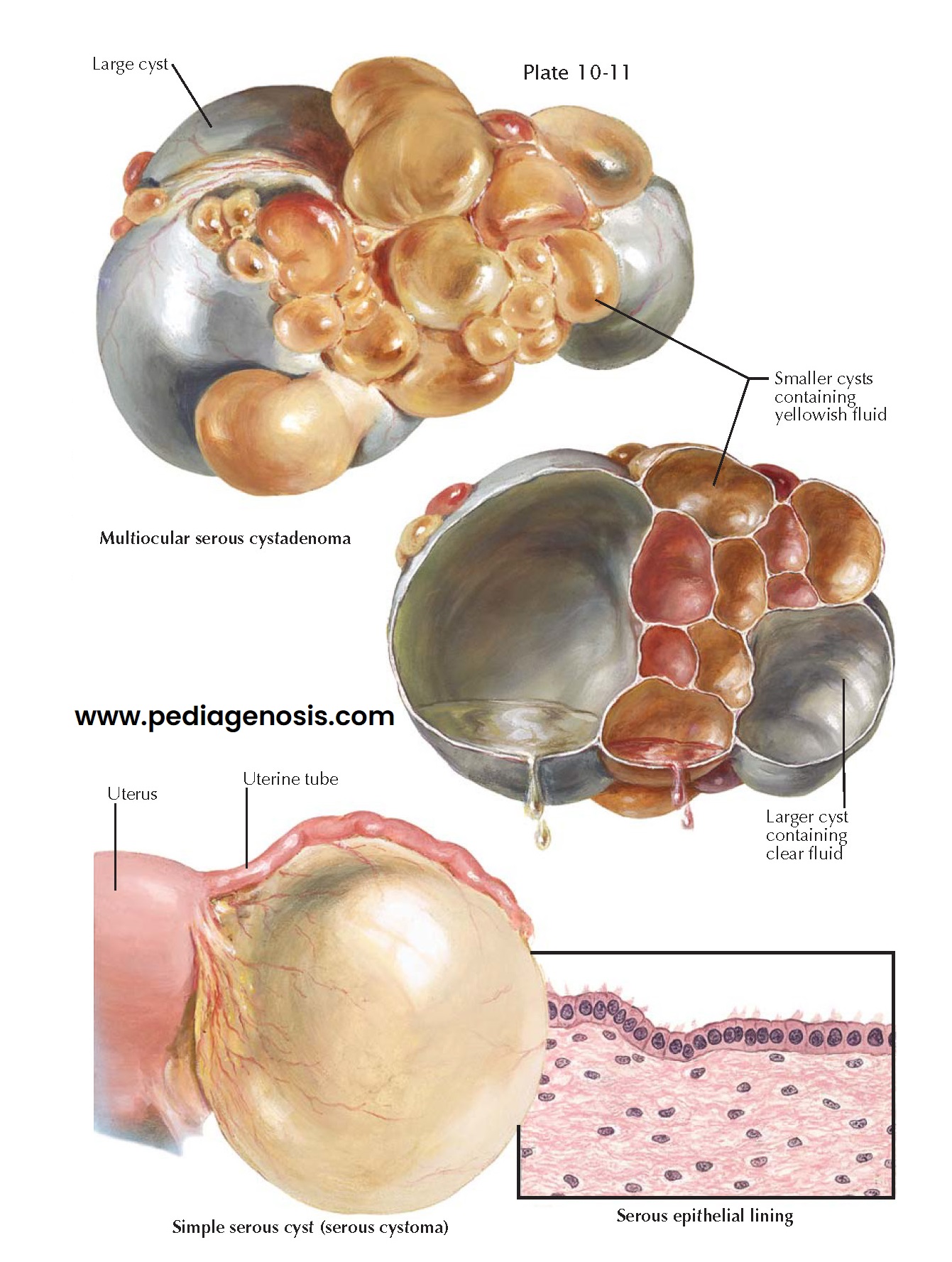SEROUS CYSTOMA AND CYSTADENOMA
Cystadenomas are the most common ovarian neoplasms. Benign ovarian tumors are most frequently diagnosed at the time of routine examination and are asymptomatic. They are divisible, according to their lining epithelium, into serous and mucinous varieties. Approximately 90% of ovarian tumors encountered in younger women are benign and metabolically inactive. More than 75% of the benign adnexal masses are functional. Functional cysts are not true neoplasms but rather are anatomic variants resulting from the normal function of the ovary.
The proliferating elements in serous cysts include a connective tissue as
well as an epithelial component. Depending upon the rate of growth and
predominance of each of these constituents, a variety of neoplastic patterns
have evolved. These present gross and microscopic differences of sufficient
degree to warrant division into subgroups. The simplest form is the serous
cystoma, in which a single layer of cuboidal epithelium lines a fibrous cyst
wall. In serous cystadenomas, the epithelium shows increased adenomatous
proliferation. Papillary serous cystadenomas manifest an additional tendency
toward papillary epithelioid growths. In surface papillomas, a single layer of
“serous” epithelium covers numerous fibromatous excrescences. When fibrous tissue
proliferation is accentuated and the “serous” epithelium retains an adenomatous
tendency, the term fibroadenoma, or adenofibroma, is applied. If
this variant includes cystic dilations of conspicuous size, it may be
designated as a serous cystadenofibroma.
The simple serous cyst (serous cystoma) is a unilocular ovarian cyst
lined by “serous” epithelium. Although a large size may be attained, it rarely
exceeds that of an orange. It is usually unilateral, oval, or spherical in
shape, thin-walled, smooth-surfaced, and grayish-white or translucent amber in
color. On section, the thin walls collapse, with the escape of a clear, serous,
watery, or straw-colored fluid. The latter is rich in serum proteins and lacks
the viscid quality of mucinous fluid. The inner lining appears smooth and
glistening. Microscopically, the characteristic “serous” epithelium is composed
of a single layer of cuboidal or low cylindrical cells, with central,
dark-staining nuclei. Cilia may be demonstrable. The lamellated, fibromatous
tissue comprising the rest of the cyst wall is devoid of adenomatous
structures. Occasionally, flattened, verrucous papillae may be found on the
inner surface, made up of connective tissue cores covered by cuboidal
epithelium similar to that lining the cyst.
The serous cystadenoma is a uni- or multilocular serous cyst of the ovary
with glandlike, adenomatous, epithelial proliferations in its wall. It is
generally smaller than the mucinous variety but may reach the size of a child’s
head. On rare occasions, it may be huge. Bilateral ovarian involvement is
frequent. When multilocular, the cystadenomas are irregular in shape, with a
bossed, smooth surface, traversed by many fine vessels. The color may vary in
individual locules. A thickened, fibrous wall may appear grayish white.
Depending upon the degree of hemorrhagic discoloration, the
component cysts may appear amber, brown, red, blue, or purple.
Hemisection of a multilocular serous cystadenoma reveals chambers of varying
size. The intervening septa may be thin, thick, partial, or complete.
Communications between locules are established as a result of pressure
necrosis. In the more solid portions of the intercystic septa, small daughter
cysts may be evident. Histologically, a typical single layer of cuboidal or low
columnar ciliated epithelium lines the acini and cyst walls.
The grapelike cystadenoma is a variation of the serous cystadenoma.
Multiple, individual pedunculated cysts that project from the surface of the
ovary characterize it. The tumor is multicystic rather than multilocular. The
term is derived from its resemblance to a bunch of grapes of varying size. The
histologic features are similar to those of the cystadenoma.
Simple cysts and serous cystadenomas are benign neoplasms. Cystectomy or a partial ovarian resection may suffice as therapy.





